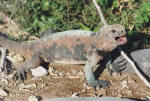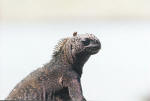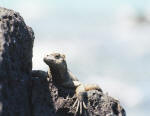The Iguanas of Galapagos, Ecuador
The best-known of the 13 species of Iguanas is the common, or green, iguana, which occurs from Mexico southward to Brazil. Males of this species reach a maximum length of over 2 metres (6.6 feet) and 6 kg (13.2 pounds). It is often seen basking in the sun on the branches of trees overhanging water, into which it will plunge if disturbed. Food of the common iguana consists largely of leaves, buds, flowers, and fruits of fig trees (genus Ficus), although many other trees are also fed upon. Whereas this lizard has a well-developed digestive system housing bacteria that ferment plant material, it also eats invertebrates when young and has been known to eat small birds and mammals.
During the rainy season, males become territorial, and mating pairs are established. At the end of the rainy season, eggs are fertilized and then laid in clutches of 30 or 50 in the ground during the early dry season. After 70-105 days, the 7.6-cm- (3-inch-) long hatchlings emerge. During this time, eggs and young are vulnerable to predators such as coatis and other omnivores. Adult iguanas have been used as food by humans for thousands of years and are threatened by hunting and habitat loss. In rural areas they are a major source of protein. The closely related West Indian iguana lives on several Caribbean islands. Other well-known relatives are the rhinoceros iguana of Haiti, the desert iguana of Mexico and the USA, and the marine (Amblyrhynchus cristatus) and land (Conolophus) iguanas of the Galápagos Islands. [- Encyclopedia Britannica 2004]
Designed in collaboration with Vitalect, Inc. All rights reserved. |




















